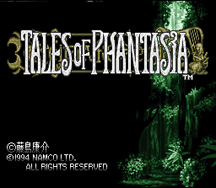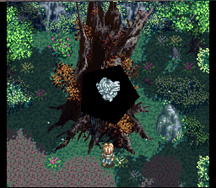Main
What's
New
Import Stores
Import Reviews
Import Cover Archive
Special Features
Games
The Top
100
Video Game Fiction
Wanted!
Acknowledgements
Forum
Links
Import Stores
Import Reviews
Import Cover Archive
Special Features
Games
The Top 100
Video Game Fiction
Wanted!
Acknowledgements
Forum
Links


I'm one of a select (elite) few that doesn't give a damn how many polygons are floating around on my television screen. I'd much rather be looking at art as it is among the only pleasures from which I never tire. "We have art to save ourselves from the truth." - Friedrich Nietzsche. And I don't care if that art is being produced by the most minuscule hardware or the best that can be made. As long as it's art, that's enough. Shortly before Namco became obsessed with 3D polygons they made one of the most visually astonishing games on the Super Famicom in 1996, Tales of Phantasia.
During the game's opening, you watch a demon called the God of War get sealed inside a pendant. Afterwards, the focus shifts to a later time in which you discover that the pendant has been passed down to a young boy named Cless, the lead character throughout the game. In the beginning you take control of both Cless and Chester, his best friend, and you can wander around town, doing the usual routine RPG stuff like searching around for things and talking to people (in Japanese of course). Eventually they head out hunting together but when they return the village is ransacked. Cless finds his father dead, and in his mother's dying words tells him that the ones who attacked the village were after his pendant. The standard RPG tale of revenge and an evil resurrection ensues.
The battles are done from a side view as opposed to the standard first-person/overhead battles as seen in countless other RPGs. Cless is the only character you can control. He's a swordfighter and you can perform combos, use special attacks, etc. The other characters cannot be controlled and you must set their AI from the menu screen. Sometimes your party acts stupid and stands there getting hit, or does other meaningless things like cast a powerful spell on a weak enemy. But eventually you come to grips with how everything works. If you've played any of the Tales of Destiny titles then you know what to expect here. Enemy designs are well accomplished and their animation is commendable, as are all of the characters on your team. The backdrops during battles are often quite detailed and sometimes contain an impressive amount of parallax. And the special effects are among the best I've ever seen on a 16-bit system.
I do have some complaints, aside from the ridiculous amount of fighting. Eventually you come across an enemy called Hellbeast and these things can really punish/kill off your party, so you have to run away whenever you see them. In order to run away, you have to make it towards either edge of the battle field and hold L and R until a timer finishes. During this time you and your team can take punishment though and it just doesn't seem like something I would've incorporated into an RPG of this style. Some of the bosses are amazingly resilient, but that's actually a good thing in my opinion, especially since most recent RPGs have simple bosses that require no real strategy other than 'attack', 'use powerful magic' and 'heal whenever necessary'. Some of these require strategy and are unpredictable. Dungeons and other such places are designed exceptionally well and include some puzzles such as stepping on switches in a particular order. It would've worked a bit better if I didn't get into a fight every few seconds which disturbs the pacing. How are you supposed to focus on these things with all the fighting? At any rate, I enjoyed the overworld map which is mode 7 just like in Final Fantasy III(VI), and later on you get to ride a mechanical bird which is just like riding the airship in FFIII. You can clearly tell that FFIII has had an influence here, not that there's anything wrong with that. At least this RPG has different gameplay than most others.
Let's talk about the soundtrack. This game is massive for a 16-bit cartridge at 48-MEGS (that's one or two more MEGS than the Neo Geo game Magician Lord!) and out of that Namco uses 16-MEGS just for sound and voice. Impressed? Not really, but they did hire some famous Japanese voice actors such as Kaneto Shiozawa who passed away on May 10th, 2000 (also did work in the Japanese version of Shining Force III. Go here to view his work), Inoue Kazuhiko, and several others. Too bad you don't really hear too much voice acting. The music is done wonderfully and there's a good variety of tracks throughout. There's even a sound test accessible from the title screen! (How often does that happen in RPGs?)
No doubt about it - Tales of Phantasia is a deep, enjoyable RPG that didn't get the attention it deserved, at least by Namco's US division. If there was half the battles I'd give it an 8. It was later remade on the PlayStation in Japan and that too was never localized, and then was remade for the GBA and so at least we have something to be fortunate about, but this is just the tip of the iceberg. Many other great RPGs have never made it outside of Japan and that is a crime.
- Michael